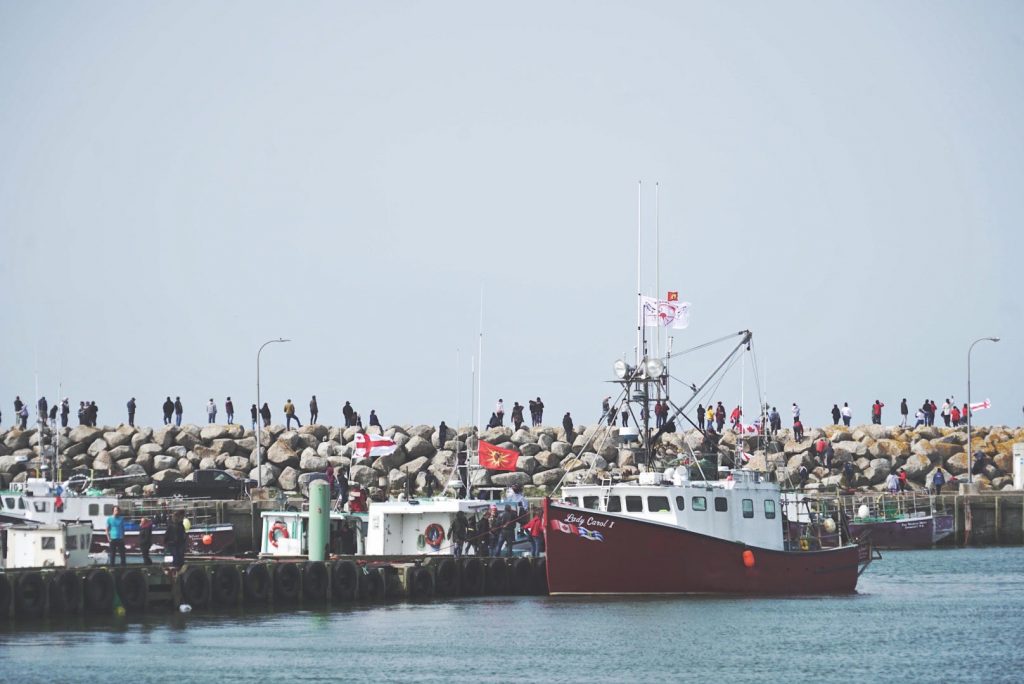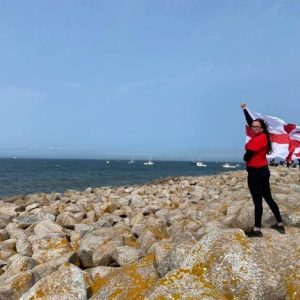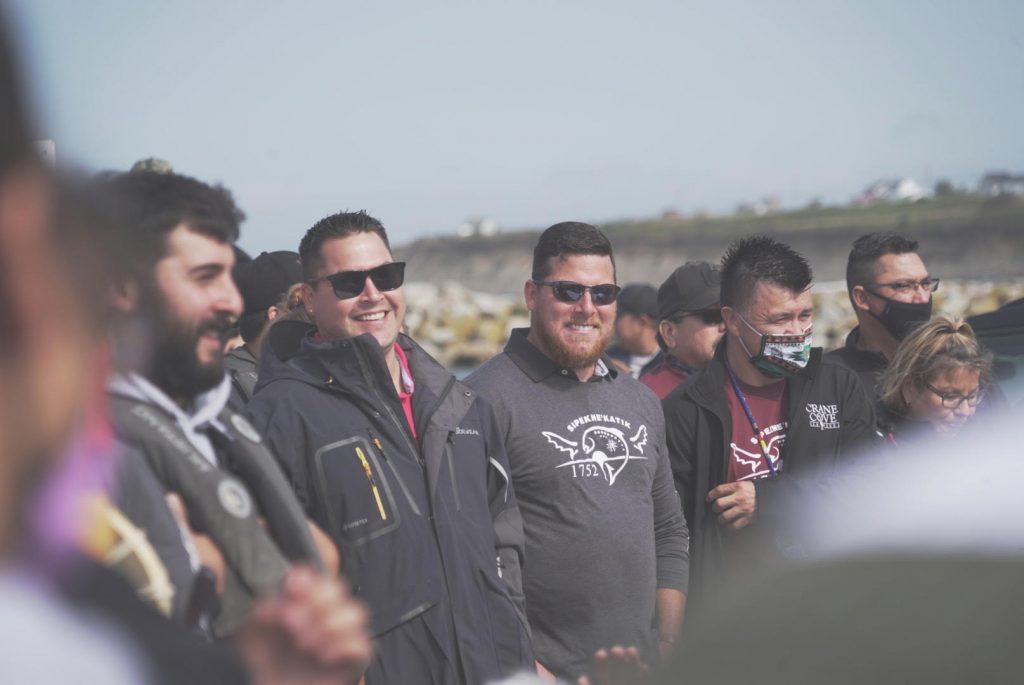The Mi’kmaq people of Sipekne’katik First Nation, in Nova Scotia, have been under attack for more than a month by local commercial fishermen, who have committed multiple acts of terrorism; setting boats, buildings and vehicles on fire, deliberately destroying thousands of Mi’kmaw caught lobsters, and physically assaulting Indigenous harvesters both on and off the water. Sipekne’katik Chief Mike Sack, who was assaulted on October 14th, told the Toronto Star, “I can’t believe how they are getting away with these terrorist, hate-crime acts.” The Nova Scotia RCMP have been harshly criticized for their lack of action in the face of so much blatant criminal activity.
Brooke Willis is a 23-year-old Mi’kmaw youth. She is an Administrative Assistant at Ulnooweg Development Group Inc. and a part-time student. She also volunteers as secretary for the Nova Scotia Native Women’s Shubenacadie chapter. Willis does all this while also showing up at Saulnierville Wharf in Digby County to show support for her people during the ongoing crisis.

September 18, 2020 – This photo was taken the day of celebration for the Indigenous fishers’ moderate livelihood tags. The celebration was short-lived, there was ‘trouble beyond those rocks’. Photo by Fallon Peter-Paul.
(This interview has been condensed and edited)
How long have you been dealing with this situation?
Brooke Willis: Before I begin this interview, I would like to acknowledge my ancestors by stating that I am a descendant of Mi’kma’ki, the traditional unceded, unsurrendered and unconquered lands of the Mi’kmaq People.
I am a direct descendant of war Chief Kobit, Jean Baptiste Cope, who signed the treaty with the British Crownin 1752.

September 17, 2020, Brooke Willis on the day the Sipekne’katik launched their self-regulated fishery. Photo by Carissa Julian.
Are you physically down on the wharf each day/night?
I go every weekend, and whenever I can get off work. I am definitely always there in my heart, keeping in touch with people who are down there. We’re all pretty connected.
How are people keeping warm/safe?
We have some Firekeepers. So, we have some fires. We’ve been asking for donations for hats, and gloves, and blankets, and some warm clothes. And, as far as keeping safe, I mean we’re doing the best that we can.
There are videos of Mi’kmaw boats being chased and rammed by commercial fishermen. And two Mi’kmaw men were trapped in the West Pubnico lobster pound by a two hundred person mob earlier this week. When you’re at the wharf, do you feel safe, or do you feel like there’s a constant threat?
There’s always that feeling that anything could happen at any moment. But, when I’m with my people, and my community, and my family, I feel safe. Amidst all this chaos, that is where I feel most at peace.
Are people on the wharf 24/7?
We have harvesters out on the water, so we have people who are there at all hours of the day monitoring, just making sure that there isn’t a threat for the time being. And we actually brought the majority of boats to one spot so we could keep an eye out and make sure no harm is done to them.
What are the most pressing issues you’re facing?
There are many pressing issues, but it would probably have to go down to our Mi’kmaq brother Donald Marshall Jr., and that Supreme Court ruling that systematically attempted to dismantle and assimilate our section 4 rights, which were granted to us in the 1752 Treaty of Peace and Friendship. The second ruling added the terminology “moderate livelihood” that goes against our 1752 Treaty Rights, which pre-date the 1761 Treaties. Section 4 of the 1752 Treaty, is extremely important regarding access to our lands and our resources within Mi’kma’ki.
“It is agreed that the said tribe of Indians shall not be hindered from, but have free liberty of hunting and fishing as usual and that if they shall think a truck house needful at the river of chibenacadie, or any other place of their resort they shall have the same built and proper merchandise, lodged therein to be exchanged for the Indians shall have to dispose of and that in the meantime the Indians shall have free liberty to bring to Halifax or any other settlement within this province, skins, feathers, fowl, fish, or any other thing they shall have liberty to dispose thereof to the best advantage.”
How do you feel about the media’s coverage of these events to date?
I feel that one narrative is being portrayed here. It’s important to have people in the media who are able to write on these things, without having their own biased opinion come into play. The media isn’t really doing a good job, and it’s not getting the coverage that it should.

Warriors: a crowd of Sipekne’katik community members watching as Randy Sack (Donald Marshall Jrs. Son) received the first set of tags. The two in the centre are a big part of the fisheries in Sipiekne’katik; Brandon Maloney (L) and John Peter-Paul (R). Photo by Fallon Peter-Paul.
Do you feel that the lack of education around Indigenous issues that exists in Canada is affecting how the media are covering this story?
There definitely could be more education when it comes to reporting on Indigenous issues. Your job (as a journalist) is to do thorough research, but that goes hand in hand with the lack of education in our school system. And it’s important to include Indigenous (journalists), they can report from a different perspective.
How do you feel about the media’s use of words like “dispute” and “protests”?
We’re not protesting our rights, we’re protecting our inherent rights. And we have people from our whole Nation coming here. It’s not just a Shubenacadie issue, it’s not just a fishing issue. The word “dispute” means an argument or a debate, but we’re not debating our rights, we’re standing up for our rights. As a Mi’kmaq youth, I feel that more treaty education needs to come out of this because there’s a lack of education in regards to Indigenous treaties. It’s not just the Mi’kmaw Nation who are facing this right now, we also have the Wet’suwet’en, and other situations that are similar to what is going on here.
How can people best show support for Mi’kmaw at this time?
We are managing a donation fund – 1752frontline@gmail.com – for our people who are here on the front line.
How do you feel about the temporary court injunction to end any form of interference with the band’s fishing activities in the south shore of Nova Scotia?
Speaking generally, it’s a step in the right direction, but it’s still an uphill battle.
Some Halifax restaurants are taking lobster off their menus, in a show of support. Does that help? Or what should chefs or restaurants know if they want to help?
Anyone using their platform or business to show support, that honestly means a lot. But if people really want to support, buying Mi’kmaw lobster would be a big one. There is not a website yet, however, the best point of contact for general inquiries would be to get in touch with the Sipekne’katik First Nation.
On social media, you can follow these accounts for up to date posts from the ground @brookewillisss, @justicegruben, @kukukwes_news, @onecraftymikmaq, @theAgentNDN , and @pam_palmater
How to use the terms Mi’kmaw and Mi’kmaq correctly, click here.
Featured illustration by Fallon Peter-Paul:
From the artist: “This is a drawing I did of one of my good friends Colton Willis. He has been down in the Digby area along with many others supporting our fishermen and also practising our treaty rights. ”
Fallon Peter-Paul is a 28-year-old Indigenous woman from the Sipekne’katik Reserve in Nova Scotia. A photographer and artist, Fallon also works as a youth mentor to children in her community. @FallonYvonne
Read more:
‘Mi’kmaw fishery isn’t a threat to conservation, say scientists’

